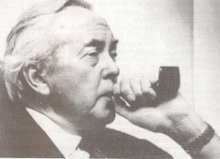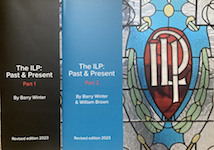5. Labour in the 70s
The Modern ILP
The ILP, which returned to the Labour Party in 1975 as Independent Labour Publications, was in many respects a shadow of its former self. But what it lacked in size and organisations it intended to make up for with political clarity, intellectual honesty and a determination to learn from the left’s past failures, including its own. Conscious that its ideas were very much minority ones, it knew that it was undertaking a big job.
 In its new endeavours, the modern ILP did not wish to live off any nostalgia about its past, however. Nor did it seek any special constitutional rights inside the Labour Party, such as affiliate status. On the contrary, the ILP firmly believed that any influence that it might eventually gain could and should only derive from its capacity to persuade people, not from direct access to the Labour Party’s decision-making procedures. A principle which it feels should apply to all wings of the party.
In its new endeavours, the modern ILP did not wish to live off any nostalgia about its past, however. Nor did it seek any special constitutional rights inside the Labour Party, such as affiliate status. On the contrary, the ILP firmly believed that any influence that it might eventually gain could and should only derive from its capacity to persuade people, not from direct access to the Labour Party’s decision-making procedures. A principle which it feels should apply to all wings of the party.
The ILP’s aim was to help create a healthy, dynamic grass roots left movement as the basis for building a radical, campaigning Labour Party. This was seen as a long term strategy. The challenge was to overcome society’s deep-seated conservatism while minimising the risk to the party’s electoral prospects.
Nor did the ILP believe that its members should seek key positions in the party to spread its ideas. Instead its approach, which has often been misunderstood, derives from a commitment to build support for radical ideas from the base upwards.
This outlook has distinguished the ILP from many on the Labour left for whom securing positions of ‘influence’ in the party is a priority. For the ILP, the strategy of replacing right-wingers by left-wingers whether on local councils or in parliament, when there is no mass basis for socialist ideas, is usually self-defeating.
Having supplied its constitution and explained its socialist ideas and purpose to representatives of Labour’s national executive, the ILP was welcomed back on that basis in 1975.
The ILP’s political re-orientation was no quick fix, however. It came after years of intensive political debate about how socialists should relate to the Labour Party. In those discussions, some claimed that left-wingers who immersed themselves in Labour Party politics shifted to the right (or were marginalised). Others argued that this was not an inevitable process, that it could be countered by a more collectivist, coherent and non-careerist, form of left politics.
The crucial turning point in the ILP’s own debates came in 1974 with the adoption of its Outline Perspective. After outlining developments in global capitalism and in British society, this identified the Labour Party as central to any attempt to build a socialist society and to connect with the working class. It also acknowledged the need to combine parliamentary and extra-parliamentary roads to socialism.
The outline perspective specifically challenged the politics of the Labour right. It opposed right-wing ‘revisionism’ which rejected socialism even as a long-term goal and which argued that it was preferable and possible to manage capitalism both more efficiently and more fairly.
Finally the perspectives document emphasised the need to build a grass roots political movement before any radical change in the party, let alone in the wider society, could be sustained – a view that has remained constant in the modern ILP’s literature. It was these perspectives that were to guide the ILP in subsequent years.
Labour in the 70s
The ILP returned to a Labour Party which was itself in a state of considerable flux. Put crudely, the Labour right, which had been in control for decades, was losing political credibility and the left was making something of a comeback.
 In part, this was because the Wilson governments of 1964-70 had generated widespread dissatisfaction within the labour movement. In particular, their attempt to cub industrial militancy by shackling the unions, had weakened party leaders’ close, traditional links with leading trade unionists. Union leaders were themselves under pressure from a layer of more radical activists.
In part, this was because the Wilson governments of 1964-70 had generated widespread dissatisfaction within the labour movement. In particular, their attempt to cub industrial militancy by shackling the unions, had weakened party leaders’ close, traditional links with leading trade unionists. Union leaders were themselves under pressure from a layer of more radical activists.
As a result, the trade-union block vote, which dominates the party conference, was no longer automatically at the disposal of the leadership as it had been for most of its history. In 1973, in these more fluid conditions, the parliamentary left, based around the Tribune Group of MPs, won conference backing for a more radical programme of government intervention.
The Labour government, which was returned to office in 1974 following the miners’ strike, soon proved to be a major disappointment to many party members. First, it tried to sidestep the party’s interventionist programme. Then, as the economic crises deepened and with the Tribune Group in disarray, it rode roughshod over the party policy. It also began a major attack on public spending.
Through its literature and campaigns, the ILP formulated a critique of Labour’s behaviour in office. It suggested the political reasons why Labour governments ended up struggling against the working class: not as a result of personal failings of particular individuals but because, when the going was rough, their political perspectives brought then into conflict with the material interests of the working class.
Unwilling to challenge, let alone control, the capitalist economy, Labour governments fall prey to its demands, the ILP argued. Instead of directing their criticisms at the failures of the capitalist system, instead of politicising people about its widespread injustices and building a movement for change, Labour leaders blamed the working class for the crises, singling out the trade unions for particular odium.
In times of economic crises, Labour governments’ attempts to restore capitalist profitability led them, no matter how reluctantly, to attack working class living standards. In so doing, they did much to confuse and thereby immobilise many people in the Labour movement, the ILP argued.
Social contract
To avoid a repeat performance of the earlier conflicts with the unions, the 1974-79 Labour administration at first worked closely with the left-of-centre trade union leaders, like Jack Jones of the transport workers and Hugh Scanlon of the engineers. With the veteran Tribune MP, Michael Foot as employment secretary, many positive trade union reforms were introduced.
In return, trade union leaders were under government pressure to contain their members’ wage demands because there were seen as the main cause of inflation. Labour leaders floated the idea of a social contract with the unions in exchange for wage restraint.
Most left-wingers opposed any attempt to curb the trade unions right to free collective bargaining and rejected any idea of the social contract. In doing so, they were heavily criticised not only for damaging the Labour government’s political prospects but also endangering economic recovery.
The ILP took a different stand. Arguing that there was nothing intrinsically socialist about free collective bargaining, it called instead for a socialist social contract in which wage rises must keep pace with inflation.
The ILP argued that only if the Labour government made real inroads into the capitalist system would wage restraint be acceptable. If that did not happen, if the capitalist system was to be left untouched, then pay restraint was simply being used to serve the interest of private profit. That was not acceptable. A Labour government must guarantee that whatever workers sacrificed in the short term would be returned to them in the future. Otherwise there should be no contract.
In propagating these alternative proposals, the ILP was not only exposing the party leadership’s limited and flawed economic strategy, it was also suggesting that the left should adopt a different kind of political and economic strategy, that it should go beyond a defensive and simply oppositional stance.
Tribune
As the Labour government continued to lurch to the right, the ILP also called for the Labour left to rally its forces to act as a political counter-weight. An open letter was sent to the Tribune Group, which was then seen as the leadership of the Labour left, asking them to give a lead to those in party who were increasingly disturbed by events.
The letter also expressed concern about the highly individualistic behaviour of many Tribune MPs. For while some left MPs were resigning from office in protest, some, notably Tony Benn, were staying put. Meanwhile others were actually accepting office. This, the ILP argued, was doing much to confuse and disarm those party members and others who were critical of the Labour government.
With a few exceptions, this call for the left to get its act together was either ignored or rejected by most of the Tribune Group. Interestingly, the most ferocious reaction came from the then up-and-coming Tribunite, Neil Kinnock in a debate published in the Tribune newspaper.
None the less, growing numbers of party members were recognising that the left had to act differently. Some left MPs felt it was necessary to set up a grass roots campaign to back them in their fights with the leadership over party policy and in 1978 the Labour Co-ordinating Committee (LCC) was born.
At this time, the Campaign for Labour Party Democracy (CLPD) grew to prominence. The CLPD had been formed a few years earlier by a group of rank and file party activists in reaction to Harold Wilson’s threat to ignore a conference motion on public ownership. The campaign believed that the party could be radicalised by making MPs more accountable to constituency activists. They called for mandatory selection (so that in the lifetime of each parliament, constituency parties had the automatic right to decide whether or not to change their parliamentary candidate). Many Labour MPs found this reasonable demand highly offensive and resisted it with great bitterness.
While the ILP did not share the strategic political thinking behind these two quite separate political initiatives, it gave broad support to both. For many years, ILPers participated in the work of the LCC while it offered a forum for left ideas and promoted democratic reform in the party. Indeed, the ILP pioneered the call for the party leader to be elected by an electoral college and not just by Labour MPs.
Only later did the underlying political differences about social change make it impossible for the ILP to cooperate with what was becoming known as the Bennite left on party democracy and the role of the Left.
—-
 This is an extract from the original centenary edition of The ILP: Past & Present, published in 1993. The print version is now sold out.
This is an extract from the original centenary edition of The ILP: Past & Present, published in 1993. The print version is now sold out.
The latest revised and updated version, published in 2023 to mark our 130th anniversary, is available to buy in two parts from our publications section.


